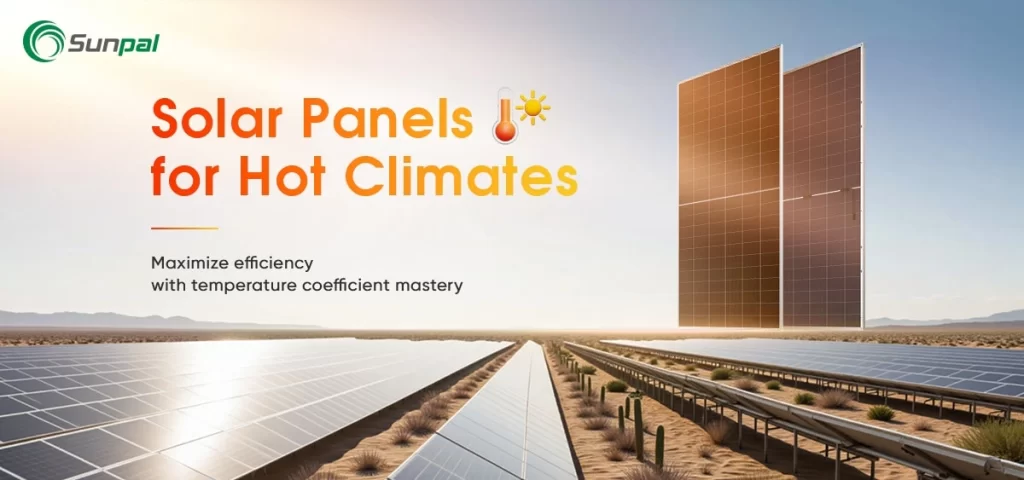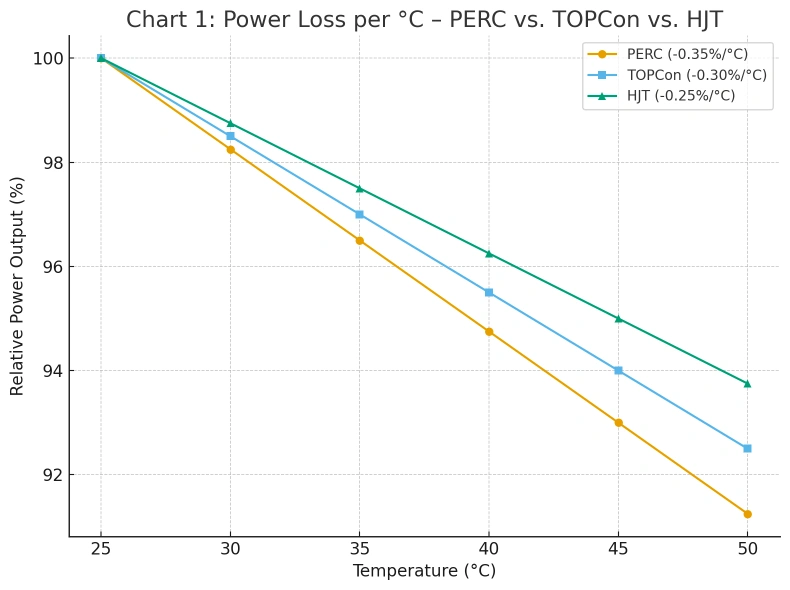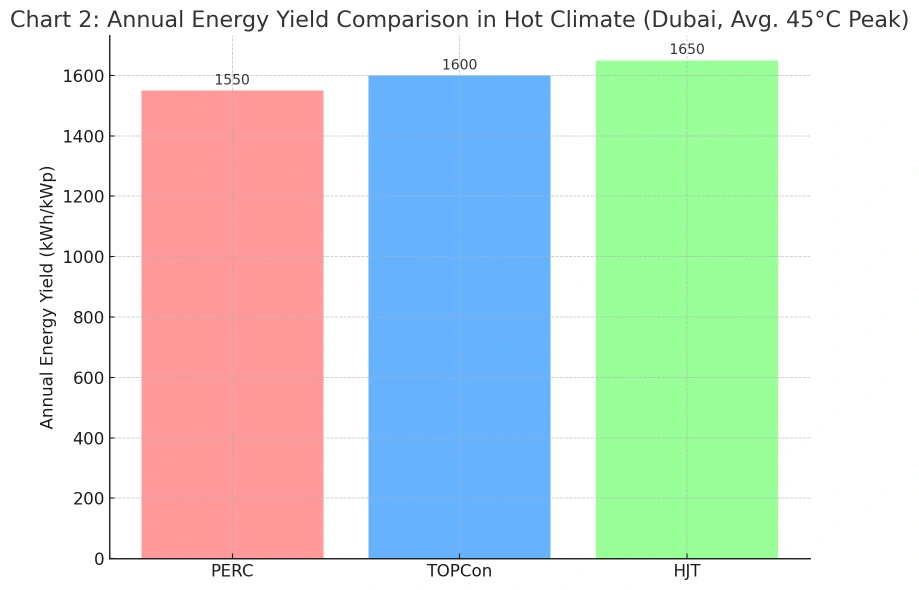
Unlocking Solar Efficiency Where It Matters Most
High temperatures pose one of the greatest challenges to solar power generation. While abundant sunshine fuels photovoltaic systems, excessive heat reduces panel efficiency, impacting long-term returns. For businesses and developers in hot regions—such as the Middle East, Southeast Asia, Africa, and the Southern U.S.—understanding the temperature coefficient of الألواح الشمسية is critical to ensuring stable yields and reliable ROI.
Why Temperature Coefficient Matters in Solar PV Performance
For solar developers, panel choice goes far beyond peak efficiency ratings. The temperature coefficient of power (Pmax) measures how much output declines for each °C rise above 25°C. In hot climates, this seemingly small percentage directly determines how much usable electricity systems can generate over decades of operation.
Different solar technologies exhibit distinct thermal behaviors:
- PERC Panels: The industry workhorse, widely available and cost-effective. But they carry higher heat sensitivity, with a coefficient of around -0.35%/°C.
- TOPCon Panels: By improving passivation layers, TOPCon reduces electron recombination losses, with a coefficient near -0.30%/°C, offering a stronger balance of cost and heat stability.
- لوحات HJT: The leader in thermal performance, with coefficients as low as -0.25%/°C, enabling superior efficiency retention even above 40°C.
The cumulative effect is substantial. A 100 MW solar farm in a climate averaging 40°C could generate 1–2 GWh more annually with HJT modules compared to PERC, significantly impacting project bankability.
Chart 1: Power Loss per °C – PERC vs. TOPCon vs. HJT

Market Context: Solar Growth in Hot Regions
- India is racing toward its ambitious target of 500 GW of renewables by 2030, with more than half expected from solar.
- The Middle East, led by the UAE and Saudi Arabia, is investing billions into utility-scale PV projects, such as Dubai's Mohammed bin Rashid Al Maktoum Solar Park.
- أفريقيا is increasingly adopting solar PV for both rural electrification and urban industrial hubs, with C&I rooftop solar growing by 20% annually.
- جنوب شرق آسيا, including Vietnam, Thailand, and the Philippines, is rapidly scaling distributed PV due to rising energy demand and reliance on imports.
For these regions, modules with strong temperature resilience are not just technical necessities—they are essential for meeting national renewable energy targets, reducing levelized cost of energy (LCOE), and securing project finance.
Technology Comparison: PERC vs. TOPCon vs. HJT in Hot Climates
Not all solar panels perform equally under thermal stress. Let's compare three leading technologies:
وحدات PERC النمطية
- Pros: Mature supply chain, most cost-effective option, global availability.
- Cons: Coefficient of -0.35%/°C results in notable yield loss in climates with frequent 40–50°C conditions.
- Best Fit: Regions with moderate climates or projects with strict CAPEX limits.
TOPCon Modules
- Pros: Improved passivation and bifacial gains, thermal coefficient ~-0.30%/°C.
- Performance: Delivers 2–3% more energy annually in hot regions compared to PERC.
- Best Fit: Utility-scale and C&I projects balancing cost and high performance.
HJT Modules
- Pros: Leading temperature coefficient (~-0.25%/°C) and higher bifaciality (>90%).
- Performance: Can outperform PERC by 4–6% annually in desert climates.
- Cons: Higher upfront module cost, though offset by shorter payback.
- Best Fit: Harsh, high-temperature environments where long-term yield optimization outweighs CAPEX.
Chart 2: Annual Energy Yield Comparison in Hot Climate (Dubai, Avg. 45°C Peak)

Design & Certification Considerations
Panel selection is only part of the equation. To ensure optimal performance in hot climates, developers must also prioritize system design and component quality:
- متانة: Glass-glass module structures, UV-resistant encapsulants, and PID-free designs.
- Thermal Management: Mounting solutions that maximize airflow and prevent heat buildup.
- Certifications: IEC 61215 (thermal cycling), IEC 61701 (humidity), and IEC 62804 (potential induced degradation) are crucial in desert or tropical installations.
- LCOE Optimization: Lower temperature coefficients reduce degradation-related costs, improving system IRR and investor confidence.
Case Study: Maximizing Returns in Desert Heat
Sunpal Solar recently deployed a 50 MW commercial project in the Middle East using TOPCon panels with a -0.29%/°C coefficient. Compared with a reference PERC project, the system achieved 3.8% higher annual generation, equal to an additional 1.9 GWh of clean electricity.
Financially, this translated to an accelerated payback period shortened by 10 months, boosting investor returns and ensuring reliable energy delivery during peak summer months when demand is highest.
Such results illustrate the financial and technical importance of aligning module technology with climate realities.
Industry Expert Insight
Dr. Zhang, Chief Engineer at Sunpal Solar, notes:
“Temperature coefficient is more than a technical specification—it determines whether a solar plant in a hot region delivers consistent value or underperforms. By advancing TOPCon and HJT technologies, Sunpal ensures that our customers achieve reliable returns even in climates exceeding 45°C.”
Policy & Market Drivers
Governments in hot-climate markets are playing a vital role in shaping PV adoption trends:
- India: Offering Production Linked Incentives (PLI) for high-efficiency cell manufacturing, encouraging adoption of advanced TOPCon and HJT.
- UAE & Saudi Arabia: Integrating climate-adapted PV modules into utility-scale procurement standards.
- أفريقيا: Development finance institutions are funding C&I PV projects, prioritizing panels with proven hot-climate performance.
- ASEAN Nations: Implementing net-metering and rooftop subsidies, requiring panels that maintain consistent yields in tropical conditions.
Such frameworks push EPCs and developers to move beyond lowest-cost modules, focusing instead on long-term system reliability and yield stability.
Conclusion: Mastering Solar for Hot Climates
Temperature coefficient mastery is at the heart of solar success in high-heat environments. For EPCs, developers, and investors, choosing between PERC, TOPCon, and HJT modules requires a clear understanding of how thermal performance translates into project yield, LCOE, and ROI.
صنبال للطاقة الشمسية is committed to delivering climate-resilient solar technologies. By leveraging advanced module engineering, we empower businesses, governments, and communities to harness reliable, profitable solar energy where it is needed most—under the world's toughest climates.
